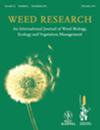采用非化学方法结合降低用量的吡嗪吡韦在平豆杂草管理中的应用
IF 2.2
3区 农林科学
Q2 AGRONOMY
引用次数: 1
摘要
摘要为研究降低吡嗪吡酯施用量与非化学杂草管理对豌豆(Phaseolus vulgaris L.)杂草控制和种子产量的影响,于2016年和2017年在伊朗大不里士大学(University of Tabriz)研究基地进行了田间研究。该试验是一个阶乘随机完全区组设计,有5个水平的马西哌使用率和4个水平的非化学处理。与仅施用吡嗪吡酯(对照)相比,施用吡嗪吡酯的所有非化学杂草管理处理均降低了杂草密度和生物量。在这两年中,非化学杂草管理处理增加了平豆单株种子和与吡嗪吡嗪结合的种子产量。2017年平豆单株种子数和单株种子产量均大于2016年,0.75X和1X之间无显著差异。非化学除草处理的除草效果和豇豆种子产量的相对排名为手除草和手除草;秸秆覆盖;活的覆盖物。在可持续生产系统中,将吡嗪与非化学杂草管理相结合可以提高平豆的杂草控制效果和种子产量,同时减少除草剂的使用。本文章由计算机程序翻译,如有差异,请以英文原文为准。
Using non‐chemical options in integration with reduced rates of imazethapyr in weed management of pinto bean (Phaseolus vulgaris L.)
Abstract In order to investigate the effects of reduced imazethapyr rates integrated with non‐chemical weed management treatments on weed control and pinto bean ( Phaseolus vulgaris L.) seed yield, the field studies were carried out at the Research Field of University of Tabriz, Iran in 2016 and 2017. The experiment was a factorial randomised complete block design with five levels of imazethapyr rates and four levels of non‐chemical managements. The weed density and biomass were reduced in all non‐chemical weed management treatments when combined with imazethapyr, compared with those treated with imazethapyr only (control). In both years, non‐chemical weed management treatments increased pinto bean seeds per plant and seed yield when integrated with imazethapyr. Pinto bean seeds per plant and seed yield in 2017 were greater than those in 2016 and also there was no significant difference between those in 0.75X and 1X. The relative ranking of non‐chemical weed management treatments for weed control efficacy and pinto bean seed yield was hand weeding > straw mulch > living mulch. Integration of imazethapyr with non‐chemical weed managements could increase the weed control efficacy and seed yield of pinto bean whereas would reduce herbicide application in sustainable production systems.
求助全文
通过发布文献求助,成功后即可免费获取论文全文。
去求助
来源期刊

Weed Research
农林科学-农艺学
CiteScore
4.30
自引率
0.00%
发文量
41
审稿时长
12-24 weeks
期刊介绍:
Weed Research is an international peer-reviewed journal that publishes topical and innovative papers on weed science, in the English language. Its aim is to publish the best weed science from around the globe and to be the journal of choice for weed science researchers. It is the official journal of the European Weed Research Society. Papers are taken on all aspects of weeds, defined as plants that impact adversely on economic, aesthetic or environmental aspects of any system. Topics include, amongst others, weed biology and control, herbicides, invasive plant species in all environments, population and spatial biology, modelling, genetics, biodiversity and parasitic plants. The journal welcomes submissions on work carried out in any part of the world.
 求助内容:
求助内容: 应助结果提醒方式:
应助结果提醒方式:


